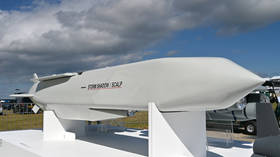Space scavenger attack: Pentagon builds cannibal satellite (VIDEO)
The Pentagon’s “mad scientists’ division” wants to harvest dead communication satellites for spare parts and re-use them in orbit. The program, called Phoenix, may hold an orbital trial phase by 2015.
The project kicked off last year and has entered a new phase this week, after the Defense Advanced Research Projects Agency (DARPA) issued a bid to commercial satellite owners. They are asking for old spacecraft which could be dissected by its robotic space cannibal as proof of the concept, reports Wired.The agency also hosted a conference attended by academics, private companies and military experts to discuss technological and regulatory challenges of the $36 million program.The idea DARPA has is to put into geosynchronous orbit (GEO) a servicing satellite equipped with robotic arms and other tools needed to harvest re-usable details in space. The so-called tender would roam the neighborhood and prey on defunct satellites for things like antennae and apertures which can be reused at a much lower cost than if the same parts were boosted from earth.
Next, an array of smaller spacecraft called satlets would be delivered as ride-along payload with commercial satellite launches. The nanosatellites would be picked up and stored by the tender to be attached to salvaged antennae to serve as new controllers. The resulting spacecraft would then be placed into new positions and be used by the US military on the ground for communication.There are technological challenges of disassembling old satellites which were not designed with such recycling in mind. The tender would be controlled from the ground, with DARPA program manager David Barnhart describing the process as “trying to assemble via remote control multiple Lego at the same time while looking through a telescope,” for the operator.Apart from that, there are also regulatory problems. GEO slots hanging some 37,000 km right above the equator are in short supply and there is high demand from communication firms and governmental agencies. So parking a satellite into one and obtaining a radio frequency reservation for it requires a lot of red tape.Nevertheless, DARPA is pushing ahead with the program. Last week the agency awarded its first $2.5 million contract under Phoenix to a California-based firm with experience in building inexpensive microsatellites.














